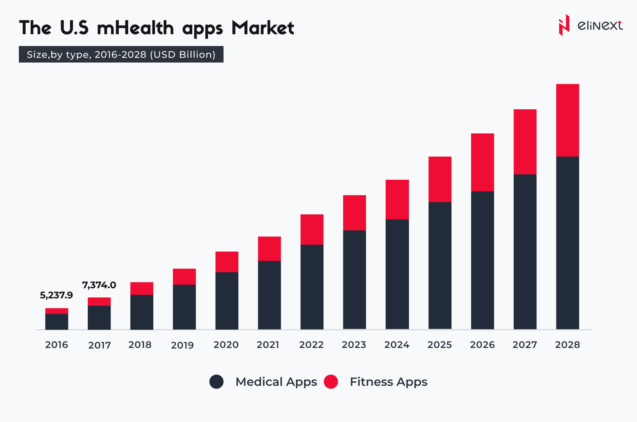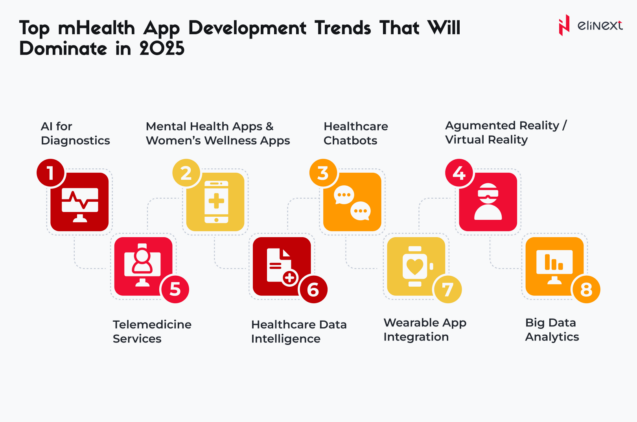In 2025, mobile app for healthcare and health monitoring app adoption is surging, with the global mHealth market projected to reach $81.7B. Trends include AI-powered diagnostics, telemedicine, wearables, and blockchain for data security. Healthcare software development services are now focused on personalized care, remote monitoring, and seamless integration with electronic health records (EHRs). AI-powered health monitoring apps predict risks and automate alerts, improving outcomes and efficiency.
Do mHealth Apps Really Work?
Healthy lifestyle apps actually work. Studies showed that health monitoring app encourage participants to exercise more, eat healthier food with lower calories, walk more steps, and sleep longer on a daily basis.
Users of mHealth apps become more engaged and autonomous when it comes to their health. They are more motivated to improve their lifestyle and more consistent in keeping it up compared to the non-users. A survey conducted by Health IT Outcomes in 2019 showed that 93% of physicians believe that such applications can help improve patient health.
mHealth Apps: Market Growth and Types
Apps for healthy lifestyle are driving the rapid growth of mobile health, with the market expected to reach $86.4 billion by 2030. Healthy lifestyle apps cover fitness, nutrition, mental well-being, and chronic disease management. Fitness trackers and meal planners are among the most downloaded, while telemedicine and remote monitoring apps are expanding access to healthcare and preventative services worldwide.

Key Takeaways
- The global mobile health market is expected to grow from $71.6 billion in 2024 to $268.46 billion by 2034, a 275% increase driven by mobile health apps and digital transformation.
- Telemedicine is experiencing rapid growth, with the market expected to reach $460 billion by 2030, as health monitoring apps enable remote consultations and treatment of chronic diseases.
- Wellness apps, such as fitness trackers and nutrition tracking apps, are projected to generate $9.9 billion by 2030, reflecting the high demand for preventative care and mental well-being support.
mHealth Apps for a Healthy Lifestyle to Try
As mentioned before, apps for healthy lifestyle include apps that focus on a healthy diet, nutrition, exercise, fitness, lifestyle, and mental health. We’ll cover apps that promote one or more of these categories in a way that is creative, evidence-based, effective, and doesn’t have any prove side-effects.
Noom
Noom is a popular and much-praised diet and nutrition app, whose main method is to change the user’s behavior. The app tracks weight and food intakes, counts calories, and connects you to the community of people who also want to eat healthier.
Fabulous
Fabulous is a routine-building app. It gives you a choice of healthy routines and allows you to select any of the goals you want to focus on: feel more energized, lose weight, sleep better, or focus and concentrate. It starts you off with something easy, such as having a glass of water every day after you wake up. Every morning, it sends you notifications, reminding you to drink some water at the time you specify.
Strava
Strava is a fitness app and a workout routine maker that is designed for those motivated by competition, community, and peer pressure. The developers behind Strava know that human beings are social beings, and they often require other people when they choose to run, swim, or bike. Strava lets the user join group workout challenges, follow your friends’ activities, and share photos of oneself on a morning run.
Sleep Cycle
People generally underestimate the importance of sleep for their health. They go to sleep late and wake up early to have time for other health-related activities, such as exercises, morning runs, and meditation practices. Sleep Cycle is an app that helps at teaching you how to sleep more and better, and how to fall asleep easier; its alarm clock wakes you up according to your circadian rhythms.
MindDoc
MindDoc helps the users take care of their mental health. It might be more suitable for those already struggling with anxiety or depression, however, it could also be useful for healthy individuals. The app acts as a mood journal: it regularly asks you questions, answering which helps you track your emotional state and observe how your emotional state changes in relation to other areas in your life.
Order development now to provide telemedicine, remote monitoring, AI-powered triage and secure integration with electronic medical records.
Take advantage of the key trends in healthcare mobile apps that will dominate.
What are the Key Healthcare Mobile App Trends
-
AI-Powered Diagnostics & Predictive Analytics
Artificial intelligence development solutions are revolutionizing healthcare applications. AI-powered diagnostic apps analyze medical images and predict disease risks, enabling early intervention. Predictive analytics in health monitoring app platforms helps healthcare providers personalize treatment and reduce readmissions.
-
Personalized Telemedicine & Remote Monitoring
Telemedicine app development solutions now offer personalized care through video consultations and real-time remote monitoring. Patients with chronic conditions use mobile apps to share vital signs with doctors, receive personalized consultations, and reduce the number of in-person visits, improving outcomes and patient satisfaction.
-
Mental Health Apps
Apps now offer AI-powered mood tracking, personalized coping strategies, and virtual therapy. Lifestyle management software is changing the way we approach mental health. Users gain access to meditation, stress management, and peer support, making mental health resources more accessible and reducing stigma.
-
Wearables & Internet of Medical Things (IoMT)
Smartwatches track heart rate and sleep, transmitting real-time data to medical apps. This enables early detection of problems, the provision of personalized interventions, and improved chronic disease management. Medical device software development services integrate wearables and the Internet of Things for continuous health monitoring.
-
Voice Assistants & Conversational Interfaces
Mobile app for healthcare and health monitoring app platforms now support voice assistants for hands-free interaction. Patients use conversational interfaces to schedule appointments, receive medication reminders, and access medical information, increasing accessibility and engagement, especially for older adults.
-
Gamification Elements
AR/VR app development services are adding gamification to healthcare apps, increasing engagement. Fitness apps use challenges, badges, and leaderboards to motivate users, while virtual reality rehabilitation games make physical therapy engaging, increasing patient adherence and improving treatment outcomes.
-
Blockchain in Healthcare
Patients control access to their medical records, while smart contracts automate insurance claims processing, reducing fraud and increasing trust in digital healthcare. Blockchain development solutions and mobile app for healthcare utilize blockchain to securely and tamper-proofly store medical data.
-
Big Data for Personalization
Big data development services and mobile app for healthcare solutions use big data to personalize treatment. The apps analyze electronic health records, wearable devices, and lifestyle data to provide personalized health recommendations, predict risks, and optimize treatment plans for each user.

“As healthy lifestyle apps evolve, we see a shift toward hyper-personalization, AI-powered analytics, and seamless integration with wearables. The future lies in solutions that allow users to proactively manage their well-being, combining preventative care, mental health support, and real-time feedback for truly holistic health management.”
Elinext software development expert
Conclusion
Patient care management solutions and best health apps are ushering in a new era of healthcare. In 2025, trends such as AI-powered diagnostics, telemedicine, wearables, and blockchain will make care more personalized, accessible, and safe. Best health apps now offer real-time monitoring, virtual visits, and personalized wellness plans, empowering patients and improving outcomes across the entire care continuum.
FAQ
How are AI and ML transforming healthcare mobile apps?
AI-powered apps track mood changes, suggest coping strategies, and optimize workout and nutrition plans for each person. Lifestyle management software uses artificial intelligence and machine learning to analyze user data, predict health risks, and provide personalized recommendations.
How is telemedicine evolving via mobile apps?
Mobile app for healthcare now offer seamless telemedicine, including video consultations, secure messaging, and remote monitoring. Patients can connect with doctors, share medical data, and receive care from the comfort of their homes, increasing accessibility and convenience.
How are AR and VR being used in healthcare apps?
Best health apps use AR and VR for immersive medical training, patient education, and rehabilitation. Virtual reality-based therapy apps help patients regain motor skills, while augmented reality overlays help surgeons monitor anatomical structures in real time during procedures.
How important are data security and compliance?
Protecting sensitive medical data with encryption and adhering to regulations like HIPAA/GDPR are critical. Secure apps build user trust and prevent breaches by ensuring safe access to digital health services. Lifestyle management software should prioritize data security and regulatory compliance.
What about mental health, personalization, and UX trends?
Apps for healthy lifestyle now focused on mental health, personalization, and user experience. Mental health apps offer AI-powered mood tracking, personalized interventions, and intuitive interfaces, making support accessible, engaging, and tailored to each user.









